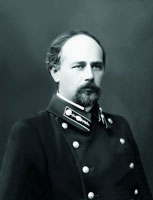
Mykola Dmytrovych Leontovych (December 13, 1877 – January 23, 1921)
Mykola Dmytrovych Leontovych (born December 13 [December 1, O.S.], 1877, the village of Monastyrok, Ukraine – died January 23, 1921, Markivka, near Tul′chyn, Ukraine) was a prominent Ukrainian composer, ethnomusicologist, choral conductor, educator and public figure whose music was inspired by Ukrainian national music school. He drew inspiration from traditional Ukrainian music, making him an ideal choice for the job. Leontovych is well-known by his Christmas choral work The Carol of the Bells (in Ukrainian the song is called Shchedryk, composed in 1916), the melody of which has become a classic around the world. It’s an integral attribute of Christmas holidays. Leontovych’s The Carol of the Bells has been used in several serials and films, such as Home Alone, Harry Potter, South Park, The Simpsons, The Griffins, and Die Hard 2 and others. It is also widely used in advertising. The Carol of the Bells has been arranged hundreds of times for different genres including classical, choral, jazz, rock, metal, R&B, and pop. Leontovych did more than 200 arrangements of Ukrainian folk songs (chiefly a capella), as well as of revolutionary and Russian songs. His music was inspired by Ukrainian national music school and by works of another famous Ukrainian composer Mykola Lysenko. Leontovych’s unfinished opera On Rusalka’s Easter (Na Rusalchyn Velykden’) was completed and orchestrated by Myroslav Skoryk.
Contents
BIOGRAPHY
Family and childhood
Mykola Leontovych was born in the village of Monastyrok, Ukraine, in 1877. His father, Dmytro Feofanovych Leontovych, came from a family of hereditary priests, but, like his grandfather and great-grandfather, he combined religious services with teaching. Mykola’s father, Dmytro Feofanovych Leontovych, was skilled at singing and played various musical instruments – cello, double bass, violin, harmonium and guitar and for some time he directed the choir of seminarians. His mother, Mariya Yosypivna, was a singer. She knew many Ukrainian songs and taught the son some folk songs.
The family had five children, Mykola was the firstborn, Alexander, Victoria, Elena and Maria followed him. Mykola with his brother, Alexander, and sisters, Maria and Elena, always sang and played various musical instruments while growing up. All children of the family had musical talent, but Mykola surpassed them all. The boy did not only sing, but also conducted a peculiar chorus consisting of brothers and sisters. Leontovych received his first musical lessons from his father.
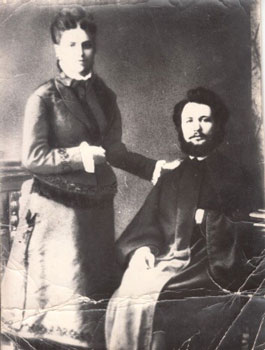
Mykola Leontovych’s parents – Dmytro Feofanovych and Mariya Yosypivna
Education
In 1879, Mykola moved to the village of Shershni where he spent his childhood. He had to follow in the family tradition and become a priest. In 1887, Leontovych was enrolled at Nemyriv gymnasium. Studying in Nemyriv was too expensive and in two years Leontovych’s father sent him to the Sharhorod Spiritual Beginners School, where students received full financial support.
In 1892, he entered Kamianets-Podilskiy Theological Seminary, where he studied music theory and choral singing, some wind instruments, and he arranged folk melodies as Mykola Lysenko, a famous Ukrainian composer to whom Leontovych is generally considered successor. At age 21, Mykola organized an amateur symphony orchestra.
Early musical career and personal life
After graduating from Theological Seminary in 1899, Leontovych broke family tradition by refusing to become a priest and started working as a vocal and maths teacher in a secondary school in the village of Chukiv. But, as before, music remained among his top priorities. Leontovych continued arranging folk songs. He was also as an organizer and director of amateur choirs and orchestras, which performed Ukrainian melodies and plays of Russian and Ukrainian composers. He bought instruments for his own money.
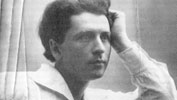
Mykola Leontovych as a young man
In 1901, he published the First Collection of Songs from Podillia. In 1902, Leontovych moved to Vinnitsa, where he got a job as a teacher at the Church Teachers’ College. On March 22, 1902 he married Claudia Feropontivna Zhovtevych, in a year, the young couple had a daughter Halyna. Later they had a second daughter named Yevheniya. In 1903, he published his Second Collection of Songs from Podillia which he dedicated to Mykola Lysenko.
The composer paid special attention to self-education. The need to systematize and improve all the self-acquired knowledge brought him to St. Petersburg Court Chapel, which was associated with composers Mikhail Glinka, Dmytro Bortniansky and Maksym Berezovsky. Being an external student, Leontovych attended classes at the St. Petersburg Court Chapel Choir during 1903-1904.
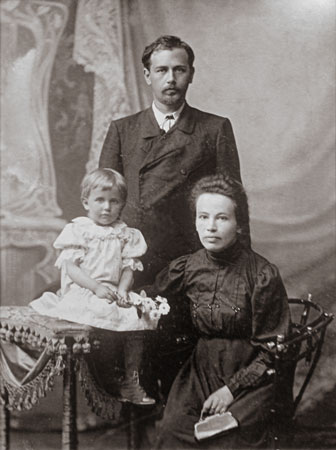
Mykola Leontovych with his wife and daughter
In 1904, Leontovych left Podillia and moved to Donbass in Eastern Ukraine, where he got a job as a teacher of singing and music at a local school for railway workers’ children in Gryshyne village (now Krasnoarmiysk). In a short period, he organized singing classes and a choir consisting of railway workers and members of their families. During the Russian Revolution of 1905, a choir of workers performed at demonstrations against the Russian monarchy.
Local authorities took an interest in Leontovych’s activity, and in 1908, due to his activities, he was forced to go back to his native Podillia, in Tulchyn, where he taught music and singing at the Tulchyn Diocesan Women’s School for the daughters of village priests.
Tulchyn period
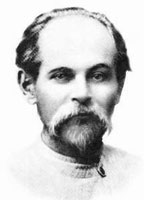
Kyrylo Stetsenko (May 12, 1882 – April 29, 1922) was a prolific Ukrainian composer, critic, conductor, educator, priest and public figure.
In Tulchyn Leontovych met composer Kyrylo Stetsenko who was Mykola Lysenko’s student and also he specialised in choral music. Stetsenko lived and worked as a priest in a nearby village. The composers’ similar life situations, solidarity in the sociopolitical standpoint, and mutual love for the Ukrainian folk music united them. Their acquaintance turned into a lasting friendship that subsequently influenced Leontovych’s music. Stetsenko wasn’t only Leontovych’s friend, he was his first music critic. Stetsenko sent several compositions to his friend, Oleksandr Koshyts, who conducted a choir in Kyiv University.
In 1909, on the recommendation of Sergey Taneyev, Leontovych had sporadic lessons with Boleslav Yavorsky in Kyiv and Moscow, he was taught periodically from 1909-1914. Tulchyn period was one of the most productive periods in Leontovych’s career, as he created numerous choral arrangements, among them were his most famous choral work well-known around the world as The Carol of the Bells (in Ukrainian the song is called Shchedryk), The Duda Player (Dudaryk), Mother Had One Daughter (Mala maty odnu dochku), Roosters Are Singing (Piyutʹ pivni), Oh, the Star Has Risen (Oy ziyshla zorya).
Leontovych’s style was heavily influenced by traditional Ukrainian chants and songs and he specialised in a cappella music. In 1906, using the melody of Shchedryk, he adapted the words into a shorter version which was published. Before Shchedryk became popular worldwide, the song lived a modest life entertaining villagers in Ukraine, especially Podillia and Volyn’. Leontovych’s Shchedryk was first performed in public in December, 1916, by the student choir at Kiev University. The performance of his arrangement brought Leontovych great success.
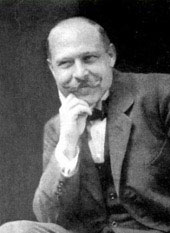
Oleksandr Koshyts (September, 12 1875 –September 21, 1944) was a Ukrainian choral conductor, composer, arranger, musicologist, writer, ethnographer, and lecturer.
In 1921 Shchedryk was heard in the United States, on October 5, the work was first performed at Carnegie Hall in New York by the Oleksandr Koshyts’s Ukrainian National Chorus, it was a huge success. Apart from Shchedryk, conductor Oleksandr Koshyts popularized many Ukrainian folk songs arranged by Leontovych.
When a popular American composer and choral conductor of Ukrainian ethnic origin Peter J. Wilhousky heard Shchedryk he decided to abandon Leontovych’s lyrics and write new lyrics in English but retained the traditional Ukrainian melody. He copyrighted the new lyrics and the song is what we now know as The Carol of the Bells. Wilhousky transformed the traditional New Year’s carol into a Christmas carol.
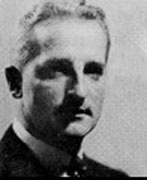
Peter J. Wilhousky (July, 13 1902 –January 4, 1978) was an American composer, choral conductor and educator of Ukrainian ethnic origin.
In 1936, the world famous The Carol of the Bells appeared, it became an integral attribute of Christmas holidays. The legendary song can be heard in modern films, including Home Alone, Harry Potter, Die Hard 2, The Simpsons, South Park, The Griffins and others.
Kyiv period
During the establishment of the Ukrainian People’s Republic, Leontovych relocated to Kyiv. He accepted the appointment of music professor at Kiev University in 1918 and also began teaching at the Mykola Lysenko Institute of Music and Drama.
Last years and unfinished opera
In September 1919 he was forced to leave Kyiv, as White Russian armies began persecuting the Ukrainian intelligentsia. Because of this, Leontovych had to return to his home in Tulchyn with his family where he opened the first music school. He collected and made choral arrangements of Ukrainian folksongs.
Leontovych started his most ambitious work, the opera On the Water Nymph's Easter or On the Mermaid’s Holiday (Na Rusalchyn Velykden’), based on a fairy tale by Borys Hrinchenko, a libretto by Nadia Tanashevych. It was his first attempt at writing a major orchestral piece. Leontovych intended to write the opera in three acts, but he would never finish it as he was killed. The poet Diodor Bobyr and a famous Ukrainian composer Myroslav Skoryk edited, completed and orchestrated the opera, but it only consists of one act.
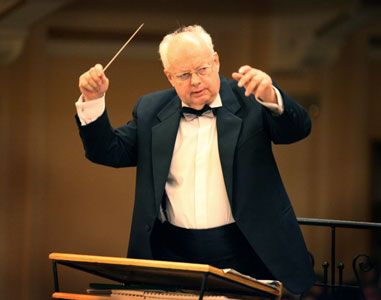
Myroslav Skoryk is an outstanding Ukrainian composer, musicologist, teacher, public figure
Assassination
Mykola Leontovych died under tragic and mysterious circumstances. According to official accounts, he was shot by a burglar, but now it is known that Leontovych was killed by an undercover Soviet Cheka agent Afanasy Gryshchenko. During the night of 22-23 January 1921, Leontovych was staying with his family on Christmas holidays in the village of Markovka. The murderer Gryshchenko came to his parents’ house and asked to spend the night in the house of Leontovych’s father. He said he was travelling on government assignment and showed his official papers. As the house had only two rooms, Leontovych and Gryshchenko had to share the same room. At dawn Cheka agent robbed the family and shot the composer. Leontovych died of blood loss in a few hours.
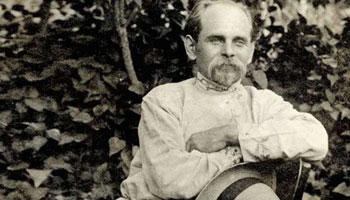
Mykola Leontovych in his last years
A patriot and proud Ukrainian, Leontovych made many enemies among the Soviets as he participated in the independence movement, aimed at promoting Ukraine as an independent state. In Soviet times the story of the assassination and the name of the murderer were thoroughly covered up, only in the 1990s when the KGB (Russian in full Komitet Gosudarstvennoy Bezopasnosti, translated in English as Committee for State Security, foreign intelligence and domestic security agency of the Soviet Union) archives were opened up, the text of the report revealed the name of the murderer and what then happened.
Leontovych’s creativity played an important role in the development of Ukrainian choral tradition and his creative principles have been adopted by many Ukrainian composers.
WORKS:
SHCHEDRYK (THE CAROL OF THE BELLS)
The Carol of the Bells started its life as something very different from the song we know today and it had nothing to do with bells. Not many know the history and origin of this Christmas carol. The Carol of the Bells is one of the world’s most famous Christmas carols originated in Ukraine, but spread all over the world as a hugely popular Christmas tune and today is being remixed and rearranged hundreds of times for different genres including classical, choral, rock, jazz, metal, R&B, and pop by musicians worldwide.
The Carol of the Bells has its roots in the melody of an old Ukrainian folk song. The melody was arranged in 1916 by Ukrainian composer, music teacher and choral conductor Mykola Leontovych and titled Shchedryk. He created a completely new work for choir using the four-note melody and original folk lyrics which intended to be a winter melody of good wishes.
Shchedryk tells a story of a swallow flying into a household to sing of plentiful year that the family will have. ‘Shchedryk’ means ‘generous’ or ‘bountiful one’. The song is an adaptation of an old shchedrivka, a song traditionally sung in many Ukrainian villages on New Year’s Eve (Shchedry Vechir) January 13 (December 31, Old Style), expressing the hope for good fortune in the year to come. As the people sang the tune predicting good fortune, they were rewarded with baked goods or other treats.
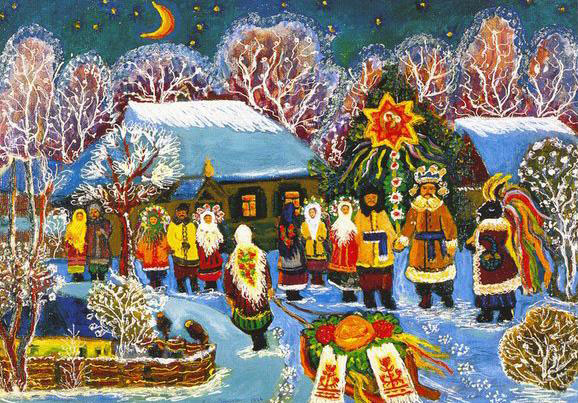
‘Shchedry Vechir’ the picture by Elizaveta Mironova, 1968
Mykola Leontovych produced five different versions of the score (1st version - 1901-1902, 2nd version 1906-1908, 3d version - 1914, 4th version - 1916, and 5th version - 1919), trying to achieve a harmonious combination of folk polyphony and classical sounding of musical instruments. The main feature of Shchedryk is the ostinato chant - a repeating pattern of four notes which continues throughout the piece.
Mykola Leontovych had been commissioned by choral conductor Oleksandr Koshyts to create song based on local folk melodies. Shchedryk was first performed in public in December, 1916, by the student choir of St. Volodymyr University (now Taras Shevchenko University) in Kyiv, conducted by Oleksandr Koshyts. The performance of Leontovych’s arrangement brought the composer great success and it was the beginning of his recognition as one of the most talented Ukrainian composers.
Being the head of the Ukrainian National Chorus Oleksandr Koshyts promoted Ukrainian music and popularized many Ukrainian folk songs in the world. Leontovich’s Shchedryk was among the works that they performed.
The song became popular in different parts of the world as they introduced it to other nationalities. A few months after Leontovych’s death, Shchedryk made its way into the United States where it was first performed to a sold-out audience on October 5, 1921 at Carnegie Hall.
When American composer and choral conductor of Ukrainian origin Peter J. Wilhousky heard Shchedryk, it reminded him of bells, so he transformed the traditional New Year’s carol Shchedryk into a Christmas carol we know today as The Carol of the Bells.
Shchedryk was published almost two decades earlier in Soviet Ukraine, but Peter J. Wilhousky copyrighted the new lyrics in 1936. While Wilhousky’s lyrics remain under copyright, Leontovych’s music is not.
Leontovych’s Shchedryk (The Carol of the Bells) has been used in many television shows, commercials and in several serials and films, such as Home Alone, Die Hard 2, The Simpsons, Harry Potter, South Park, The Griffins, and others. Shchedryk (The Carol of the Bells) has become a classic around the world and it’s an integral attribute of Christmas holidays.
SHEET MUSIC
You can find and download free scores of the composer:
Collection of Ukrainian Folk Songs Zhenchychok-brenchychok
- DOBRY VECHIR DIVCHYNO (Good Evening, Girl)
- OI LYS DO LYSYTSI (Oh, He-fox Went to She-fox)
- OI PEREPELYCHKA (Oh, She-quail)
- V POLI-POLI PLUZHOK KHODYT’ (The Little Plow is Tilling in the Field)
- HRYTSYU, HRYTSYU, DO ROBOTY (Hryts, Hryts Get to Work)
- OI SYVAYA TA I ZOZULENʹKA (Oh, Gray Cuckoo)
- KALYNO-MALYNO (Guelder Rose - Raspberry)
- A VZHE VESNA (And It’s Spring)
- OI PIDU YA V SAD HULYAT’ (Oh, I'll Go to the Orchard for a Stroll)
- CHERCHYK (The Friar)
- ZELENAIA TA LISHCHYNONKA (A Green Hazel Bush)
- POPID TERNOM STEZHECHKA (Under the Blackthorn a Little Pathway)
- OI U POLI KRYNYCHENKA (Oh, in the Field There Is a Well)
- NE KHODYLA NA ULYTSIU (I Didn’t Go on the Street)
- OI PIDU YA V LIS PO DROVA (Oh, I’m Going to the Woods for Firewood)
- NAD RICHKOIU, BEREZHKOM (Above the River and the Shore)
- ZHENCHYCHOK-BRENCHYCHOK (Reapster-bleepster)
- VYSHNI-CHERESHNI ROZVYVAIUTSIA (Cherries-black Cherries Are Growing)
- OI SYVAYA ZOZULENʹKA (Oh, Gray Cuckoo)
- OI Z-ZA HORY KAM’YANOYI (Oh, From Behind the Rocky Mountain)
- ZA HORODOM KACHKY PLYVUT’ (The Ducks are Floating Behind the Garden)
- МAК (The Poppy)
- OI KHODYT’ SEMENKO (Oh, Semenko is Walking)
- POPID YAROM, YAROM (By the Ravine)
- PRIALIA (The Spinner)
- KOZAKA NESUT’ (They’re Carrying a Cossack)
- DUDARYK (The Piper)
- SHCHEDRYK or The Carol of the Bells
Ukrainian folk songs for Mixed Choir
- DUDARYK (The Piper)
- SHCHEDRYK (Good (New Year’s) wishes)
- OI NA RICHTSI, NA YORDANI (Oh, on the river, on Jordan)
- OI POSERED DVORU (Oh, in the middle of the yard)
- OI TAM ZA HOROIU (Oh, there beyond the mountain)
- OI HORDOPYSHNYI PAN-HOSPODARIU (Oh, proud magnificent master-of-the-house)
- OI V LVOVI (Oh, in Lviv)
- KOZA (The Goat)
- V POLI-POLI PLUZHOK KHODYT (The little plow is moving in the field)-First version
- V POLI-POLI PLUZHOK KHODYT (The little plow is moving in the field)-Second version
- U NASHOMU DVORI (In our yard)
- DYVNAYA NOVYNA (Wondrous news)
- SHCHO TO ZA PREDYVO (What a wonderful miracle)
- PRECHYSTA DIVA (The Most Holy Virgo)
- NEBO I ZEMLIA (Heaven and earth)
- VOROTAR (The Gateman) (Mykola Leontovych)
- HRA V ZAICHYKA (Playing the little bunny)
- МAК (The Poppy)
- OI KHODYT SEMENKO (Oh, Semenko is walking)
- OI KHTO V TOMU LISI STUKAIE, HUKAIE (Who in this forest is knocking, whooping)
- A VZHE SONTSE ZAKHODYT (The sun is setting)
- ZHENCHYCHOK-BRENCHYCHOK (Reapster-bleepster)
- IZ-ZA HORY SNIZHOK LETYT (A light snow is flying from behind the mountain)
- OI TEMNAIA TA NEVYDNAIA NICHENKA (Oh, dark and opaque night)
- SYNIE MORE (The deep blue sea)
- OI LUHAMY-BEREHAMY (Oh, through the meadows and shores)
- OI NAS, BRATTSI, PIAT (Oh, brothers, there are five of us)
- KOZAKA NESUT (They’re carrying a Cossack)
- OI A V HORODI (Oh, in the garden)
- OI U LISI PRY DOROZI (Oh, in the forest by the road)
- OI CHAS-PORA DO KURENIA (Oh, it’s time for me to go back to my unit)
- POPID YAROM, YAROM (By the ravine)
- NA HORODI TA VSE BILI MAKY (White poppies all over the garden)
- OI Z-ZA HORY CHORNA KHMARA VSTALA (Oh, a black cloud rose upfrom behind the mountain)
- NAD RICHKOIU, BEREZHKOM (Above the river and the shore)
- OI HORE TII CHAITSI (Oh, woe to that seagull)
- OI NIKHTO ZH TAM NE BUVAV (Oh, no one came there)
- CHERCHYK (The friar)
- POMIZH TROMA DOROHAMY (Between three roads)
- NE STII, VERBO (Do not stand, willow)
- CHORNUSHKO-DUSHKO (А black-haired sweetie)
- KOTYLASIA ZIRKA (A star was rolling)
- OI U SADU HOLUBY HUDUT (Oh, pigeons are buzzing in the orchard)
- NAIKHALY HOSTONKY (The guests have arrived)
- CHEREZ SINECHKY – VYSHNEV SAD (Through the hallway – a cherry orchard)